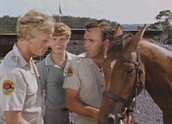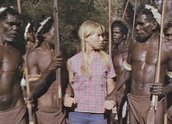


Skippy – Be Our Guest (1968)
Synopsis
Clancy (Liza Goddard) unwisely decides to go riding in the bush on the day her mother Mrs Merrick (Jessica Noad) is scheduled to visit. Thrown from her horse, dazed and lost, she is discovered by a group of Aboriginal men. Head ranger Matt Hammond (Ed Devereaux), pilot James King (Tony Bonner) and brothers Mark (Ken James) and Sonny Hammond (Garry Pankhurst) try and find Clancy without letting on to her worried mother that she is missing.
Clancy soon finds a way to communicate with the men and, despite not being not at all sure where they are going and with little faith that they will not end up in Queensland instead, follows them to arrive home just in the nick of time!
Curator’s notes
Skippy and Sonny make a very limited appearance in this episode, which is one of three episodes that feature members of the Aboriginal Theatre, from Yirrkala in Arnhem Land in the Northern Territory, while they were visiting Sydney. In fact, the only bit of Skippy magic featured in this episode is in the penultimate scene when a bedraggled and filthy trouser-wearing Clancy tells Skippy to listen very carefully and then elicits her help in finding and bringing her a dress so that she can hide her tracks and make a good impression on her visiting mother.
Skippy – Be Our Guest is episode 37 of series one. It was broadcast on the Nine Network in Melbourne on 25 March 1968 and Adelaide on 1 April 1968. See also the Skippy series page.
Secondary curator’s notes
by Sophia SambonoThis episode of Skippy was made at a time when views of Aboriginal people in Australia were slowly transforming. As Tammy mentions in her clip notes (see clip three) it was the same year as the 1967 referendum which meant Aboriginal and Torres Strait Island peoples could be counted on the census as people and not as fauna. These changing views influenced the subsequent representation of Aboriginal people in film and television in Australia.
In the 1960s – years before opportunities for self-representation developed – Indigenous people were subject to portrayal by non-Indigenous filmmakers and producers. Fortunately Lee Robinson, the series producer, depicted the ‘tribe’ favourably: as knowledgeable of the landscape and means of survival, seen in their guidance of Clancy back to the headquarters and provision of food and clean water; and as skilful and artistic, evident in their elaborate feather body adornments and the men seen painting at the campsite.
However well meaning his representation, it is still limited to stereotypes. It certainly seems strange that in the mid 1960s a group of half-naked ‘natives’ would be living off the land within a short walking distance of a New South Wales national park headquarters.
The tribe, from Yirrkala in Arnhem Land in the Northern Territory, were members of an Aboriginal theatre troupe who were visiting Sydney. They appear in this and two other 1968 Skippy stories: Tara and They’re Singing Me Back. In all three stories Aboriginal people are represented as primitive, and anywhere between mystical and menacing, with no real place in the modern world unless they assimilate to white values and beliefs. In this episode the men turn out to be kind and helpful but for almost half the episode their intentions towards Clancy are unknown and even appear sinister or threatening.
Clancy’s relationship with the tribe could be interpreted as representative of Australia’s relationship with its Indigenous peoples. She is initially frightened by their presence but, even after she finds a way to communicate with them and their intentions are clear, she remains untrusting of their abilities due to the perceived insurmountable differences between her and the men.
Interestingly, Clancy finds it easier to communicate with Skippy, one of Australia’s most famous native fauna, than with the Aboriginal men she encounters in the bush, and who were once only considered as fauna by law.
- Overview
- Curator’s notes
- Video 3 clips
- Principal credits
- Find a copy
- Make a comment
- Map
- Add your review




